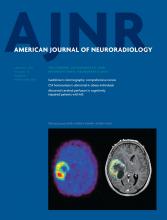With interest, we read the article of Lanzino et al1 about the use of flow diverters for proximal internal carotid artery aneurysms in 21 patients. There was a higher rate of complete occlusion at follow-up with flow diverters than in a matched series of aneurysms treated with conventional techniques (coiling, stent placement, ICA occlusion). Most important, there were no complications leading to permanent neurologic deficits or death, though 1 patient was found to have a complete ICA occlusion at 6 months without symptoms. The message in the article is that although longer follow-up is needed, flow diverters are probably better than conventional techniques for these ICA aneurysms because of a higher complete occlusion rate at follow-up.
The results in this study are exceptionally good (if we disregard the asymptomatic ICA occlusion at follow-up) and better than most previously reported series. Briganti et al2 recently reported the initial experience with flow diverters in Italy and found, in a cohort of 273 patients with unruptured aneurysms, a morbidity of 3.7% and a mortality of 5.9% at 1-month follow-up. There were 7 delayed aneurysm ruptures in aneurysms that had never bled before treatment. In posterior circulation aneurysms, the mortality went up to an alarming 19% (7 of 37). In (harmless) cavernous sinus aneurysms, the mortality was still 4% (3 of 76). Briganti et al summarize the complications of 6 large studies on flow diverters. In 471 patients, the morbidity was 4.2% (95% confidence interval [CI], 2.7%–6.5%) and the mortality was 5.1% (95% CI, 3.4%–7.5%). Also in the French experience in 64 patients, combined morbidity and mortality were higher than 10%.3 This means that almost 1 of every 10 patients with an unruptured aneurysm either dies or ends up with permanent neurologic deficits directly related to the flow-diverter treatment. In addition, at follow-up, there remains a certain risk for delayed aneurysm rupture and delayed in-stent thrombosis. Velioglu et al4 combined their results with those of 4 other studies and found that in >11% (22 of 197) of aneurysms treated with a flow diverter, the parent artery became occluded. We must realize that this high complication rate and high rate of unintended parent vessel occlusion concerns elective treatments of unruptured aneurysms with an often low chance of rupture or a benign natural history (cavernous sinus aneurysms) for which safer conventional treatments are available.
In our practice, ICA balloon occlusion is still the first choice in the treatment of (large and giant) ICA aneurysms.5 Three-quarters of patients can tolerate ICA occlusion, and this tolerance can be safely and reliably tested with angiography.6 ICA occlusion is simple to perform without the need for anesthesia, is extremely effective, safe, definitive (no imaging follow-up needed), and cheap, and leads to aneurysm shrinkage and alleviation of symptoms of mass effect in most patients. Delayed aneurysm rupture does not occur.5,7⇓–9 In contrast to the fear expressed by Lanzino et al,1 there is no increased risk for the development of de novo aneurysms in the long term and also cerebral perfusion is not impaired very long after ICA occlusion.10,11 Regardless, long-term risks after ICA occlusion are definitely much lower than the substantial risk of delayed aneurysm rupture and parent vessel occlusion after placement of flow diverters with intended preservation of the ICA.
In patients with unruptured aneurysms who cannot tolerate ICA occlusion (25% of patients), we should be reluctant to offer a treatment with a risk of delayed ICA occlusion with subsequent certain neurologic deficit or even death. Delayed ICA occlusion on follow-up may occur in >11% of cases with flow diverters, after filling the aneurysm with Onyx (ev3, Irvine, California), or after surgical bypass procedures. Selective coiling with or without stent assistance seems the safest option in these patients. In unruptured aneurysms, neck or aneurysm remnants on follow-up have little or no clinical consequences, not even in ruptured aneurysms,12 and additional coiling can be performed at a low complication rate.13,14 The risk of recurrence with conventional parent artery sparing techniques can never be an argument to proceed with dangerous flow-diverter treatment.
In patients presenting with unruptured aneurysms, our first goal is to do no harm. A treatment strategy with ICA occlusion when tolerated, selective coiling when necessary, and conservative treatment when possible (cavernous sinus aneurysms) has very low complication rates approaching 0% and is effective in preventing first-time SAH or in alleviating symptoms of mass effect and has no negative consequences in the long term. We welcome the good results of Lanzino et al1 with flow diverters. Their results are as good as those they achieved with selective coiling in 126 mostly small paraclinoid aneurysms.15 However, one swallow does not make a summer. With 10% combined morbidity and mortality together with the risk of delayed aneurysm rupture and delayed parent vessel occlusion, flow diverters should, for now, be considered a dangerous therapy for unruptured aneurysms, especially in patients who cannot tolerate ICA occlusion.
References
- © 2013 by American Journal of Neuroradiology












